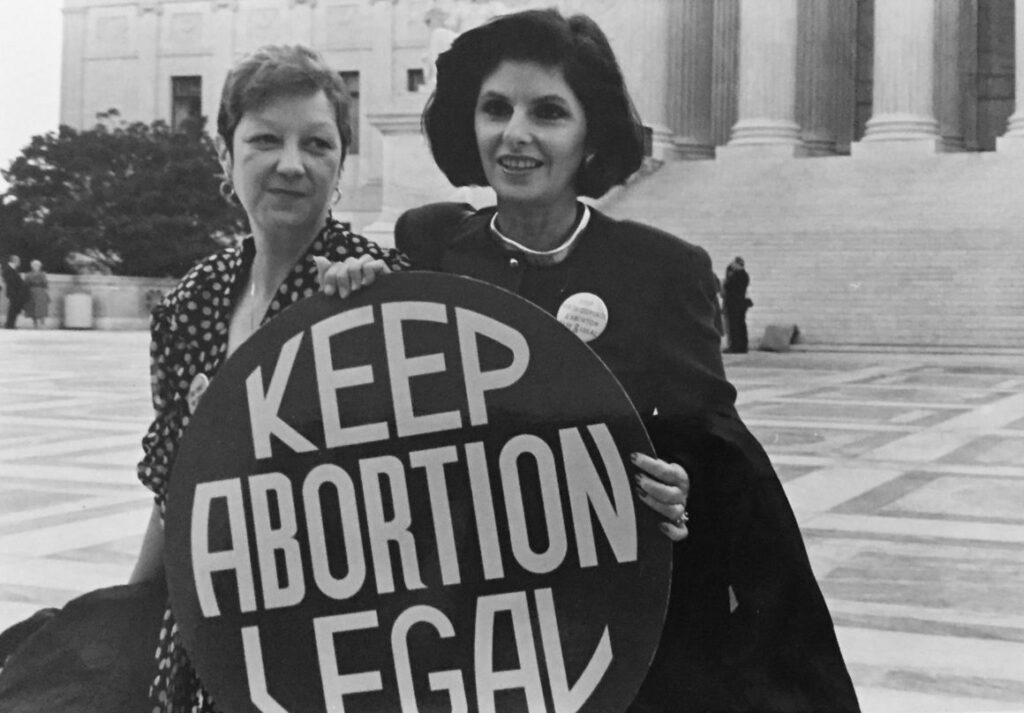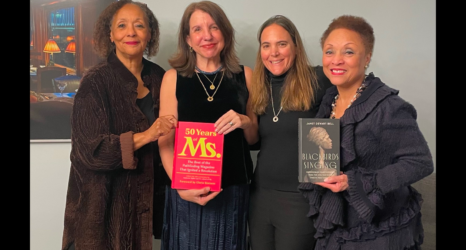As the world faces an unprecedented public health crisis and medical professionals are regarded as heroes, one medical procedure is still being politicized: abortion.
Professor Mary Ziegler from the Florida State University College of Law specializes in the legal history of reproduction, the family, sexuality and the Constitution. Her new book, “Abortion and the Law in America: Roe v. Wade to the Present” follows the legal history of abortion in the post-Roe era. She uses formerly unexplored primary sources to trace how abortion became such a polarized political battle—and to help us understand where we go from here.

Ms. reporter Katie Fleischer was able to talk with Ziegler about how the legal history of abortion informs how the procedure is viewed and treated today.
Editor’s note: The conversation has been lightly edited for length and clarity.
Katie Fleischer: The Supreme Court issued a major decision in June Medical Services v. Russo. Where does this blockbuster decision fit in the history unearthed in “Abortion and the Law”?
Mary Ziegler: June Medical comes as the culmination of a renewed attack on Roe. Ever since the Supreme Court saved Roe in 1992, leading antiabortion groups have believed that the Court would never undo the right to choose unless Americans believed that women and pregnant people did not need access to abortion to lead more equal lives.
In June Medical, abortion foes ran with these arguments. Louisiana and its allies urged the Court to uphold a restriction said to protect women and to block abortion providers from suing on patients’ behalf. Significantly, the restriction—a requirement that abortion doctors had admitting privileges at a nearby hospital—was identical to one the Supreme Court invalidated just four years earlier.
John Roberts joined his more liberal colleagues in striking down the Louisiana law challenged in June Medical. That hardly means abortion rights are safe. Roberts talked a lot about “stare decisis”—the idea that the Court should be reluctant to undo its earlier decisions. But Roberts might happily uphold other abortion restrictions that are not exact copies of ones the Court has already seen.
His opinion also had the effect of rolling back protection for abortion rights. The test that applies to abortion restrictions going forward looks much less protective than the one that came before. All of that means that Roberts’s vaunted respect for precedent might not mean much after all.
“Abortion and the Law” explores how antiabortion leaders plan to get around the idea of respect for precedent. Social movements in the abortion struggle battled for decades about what counts as a precedent and how the Court can plausibly get around decisions without looking too political. Cases like June Medical reflect our growing national divisions about the difference between public health and politics.

KF: The legal battle against Roe v. Wade has been akin to “death by a thousand cuts.” What is likely to come next after June Medical?
MZ: A close look at June Medical shows that the tools for a renewed attack on Roe are already in place. “Abortion and the Law” chronicles the rise of new laws that could let the Court roll back abortion rights, many of them built on a growing distrust of medical experts and the media. Some of these regulations build on a 2007 decision, Gonzales v. Carhart, that upheld the federal Partial-Birth Abortion Ban Act.
Antiabortion leaders believe that the Court might more readily uphold restrictions that target later abortions, especially if legislators dispute the evidence on the need for specific technique or medical issue. That means some states will invest more in laws banning all abortions after twenty weeks, or laws that outlaw specific techniques, such as dilation and evacuation, the most common procedure after the first trimester.
Red state lawmakers also want to establish that abortion does not advance constitutional equality for anyone, including pregnant people. States like Mississippi and Tennessee are the latest to introduce laws that ban abortion for reasons of race, sex or disability. And of course, states will not give up on absolute bans. There is no reason for them to. Chief Justice Roberts might still be game if one came before the Court.
KF: What is the worst-case scenario? If Roe V. Wade is overturned, what would abortion in America look like?
MZ: America already has a patchwork of laws governing abortion, and access varies dramatically from state. After Roe is gone, we would expect these differences to deepen profoundly. Some states might not only ban abortions but also potentially define “abortion” to include other health care, including some forms of contraception and reproductive technologies.
We would also expect a vigorous debate about how to enforce abortion bans in a world where women routinely travel out of state—and where it is relatively easy to buy abortion pills on the internet. So far, antiabortion groups have insisted that criminal laws would not punish patients. That promise will be very hard to keep.
Every state would see a pitched battle about how many abortions to allow—and about what the state constitution says about abortion. And since abortion-rights supporters would hardly give up on the Supreme Court, the next several decades would see both sides continuing to battle over the Court and the federal Constitution’s meaning when it comes to abortion.
KF: What does it mean that the fight over abortion has shifted in cases like June Medical from an argument over rights to one over policy costs and benefits?
MZ: This shift in the terms of the debate has fueled a subtle and ultimately more effective attack on abortion rights. Rather than focusing on the fundamental rights at stake, abortion foes have emphasized claims about the harm done by the procedure—or the benefits of specific restrictions.
This attack has already overhauled the constitutional law and politics of abortion, giving rise to restrictions on everything from fetal pain to abortion-pill reversal and creating the undue-burden test, the rule that governs every abortion dispute today. And a focus on the costs and benefits of abortion has deepened the disagreements that define the culture wars. Those on opposing sides of the abortion wars increasingly consult different experts and evidence, making it harder than ever to find common ground.
KF: What do most people misunderstand about the current legal issues surrounding abortion in America?
MZ: Most people don’t understand that regardless of what the Supreme Court ultimately says about the fate of abortion rights, we already live in a post-Roe world. Since the 1970s, abortion foes have tried to move past a discussion of the rights defining the abortion conflict, arguing that some abortion restrictions should survive because they do not harm patients. This campaign has already paid off. Since 1992, the Supreme Court has upheld a wide variety of abortion restrictions. And the Court has bolstered the idea that the government has strong interest in protecting fetal life.
All of this reminds me that we all have been lazy and imprecise about what we mean when we talk about “Roe.” Do we mean a right to choose? Actual access to abortion? In some ways, the original Roe decision is long gone. But that doesn’t mean that nothing would change if states could criminalize abortion.
KF: With the onset of COVID-19, certain states have tried to limit abortions by labeling them an elective surgery. How does that fit into the broader themes of “Abortion and the Law”?
MZ: For decades, Americans have thought of the abortion wars as a clash of fundamental rights. As states have tried to ban abortions during the COVID-19 pandemic, a very different set of questions has taken center stage: fights about the facts about abortion. In issuing COVID-19 abortion bans, states have focused not on the nature of the right to choose but on whether abortion providers use up personal protective equipment or hospital beds—and whether abortions are merely elective.
“Abortion and the Law” traces the shift in the terms of the debate that has led us to the present moment. The book shows that fights about the facts have become the centerpiece of a new—and more effective—strategy to reverse Roe. This new focus on the facts has only deepened polarization about abortion. Increasingly, those on opposing sides no longer agree on the difference between science and spin.
KF: Is there a way to mitigate the ideological gap between opponents and advocates for a woman’s right to choose? How do we cut through the bickering and red tape to have a real discussion?
MZ: Because both sides have focused (with reason) on the fate of abortion in America, we have neglected productive discussions on issues that might unite us.
We need better laws against pregnancy (and sex) discrimination in the workplace. We have a shockingly poor maternal mortality rate, especially when it comes to women of color. In theory, those on opposing sides of the abortion wars should have common cause in addressing these issues. This dialogue stalls because pro-choice and pro-life Americans disagree so strongly about basic facts—and view one another as deluded, if not dishonest or evil.
There is no easy way beyond this impasse, but it would help if those on both sides focused on the principles that drive them rather than on (mostly strategic) arguments about the costs and benefits of abortion in America.
If we could get back to a place where those on opposing sides sometimes saw one another as sincere, a real discussion could begin.
Find “Abortion and the Law in America: Roe v. Wade to the Present” here.
Want to hear more from Mary Ziegler? Check her out in episode 3 of the new Ms. podcast, “On the Issues with Michele Goodwin,” which premiered on July 28.





